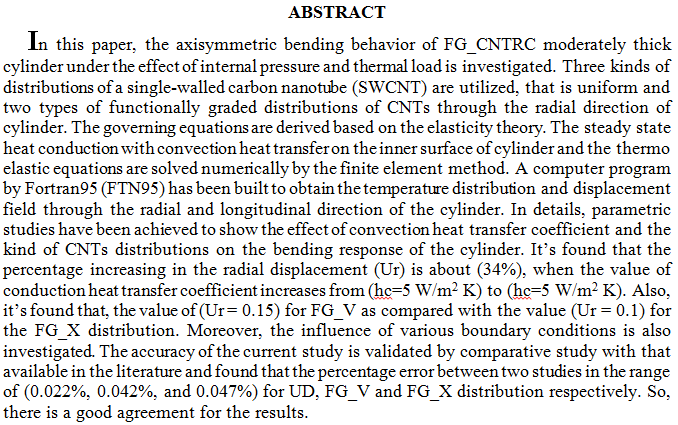
 (1)
(1)
Two types of adsorbents were used to treat oily wastewater, activated carbon and zeolite. The removal efficiencies of these materials were compared to each other. The results showed that activated carbon performed some better properties in removal of oil. The experimental methods which were employed in this investigation included batch and column studies. The former was used to evaluate the rate and equilibrium of carbon and zeolie adsorption, while the latter was used to determine treatment efficiencies and performance characteristics. Expanded bed adsorber was constructed in the column studies. In this study, the adsorption behavior of vegetable oil (corn oil) onto activated carbon and zeolite was examined as a function of the concentr
... Show More (1)
(1)
The behavior of externally prestressed composite beams under short term loading has been studied. A computer program developed originally by Oukaili to evaluate curvature is modified to evaluate the deflection of prestressed composite beam under flexural load. The analysis model based on the deformation compatibility of entire structure that allows to determine the full history of strain and stress distribution along cross section depth, deflection and stress increment in the external tendons .
The evaluation of curvatures for the composite beam involves iterations for computing the strains vectors at each node at any loading stage. The stress increment determined using equations depended on the member deflection at points of connecti
 (2)
(2)
 (10)
(10)
 (6)
(6)
The increasing requirement and use of dental implant treatments has rendered dental implantology indispensable in dentistry. The aim of this study is to determine the optimum concentration of calcium silicate to be incorporated into a polyetherketoneketone (PEKK) matrix used as an implant material to enhance the bioactivity and mechanical properties of the composite compared with unmodified PEKK. In this study, different weight percentage (wt%) of micro-calcium silicate (m-CS) is incorporated into PEKK with ethanol as a binder. Subsequently, the mixture is dried in a forced convection oven at 120°C and poured into customized molds to fabricate a bioactive composite via compression molding (310°C, 15 MPa, and 20 min holding time
... Show More (6)
(6)
 (9)
(9)
 (3)
(3)
 (1)
(1)
Linear programming currently occupies a prominent position in various fields and has wide applications, as its importance lies in being a means of studying the behavior of a large number of systems as well. It is also the simplest and easiest type of models that can be created to address industrial, commercial, military and other dilemmas. Through which to obtain the optimal quantitative value. In this research, we dealt with the post optimality solution, or what is known as sensitivity analysis, using the principle of shadow prices. The scientific solution to any problem is not a complete solution once the optimal solution is reached. Any change in the values of the model constants or what is known as the inputs of the model that will chan
... Show MoreInfrared photoconductive detectors working in the far-infrared region and room temperature were fabricated. The detectors were fabricated using three types of carbon nanotubes (CNTs); MWCNTs, COOH-MWCNTs, and short-MWCNTs. The carbon nontubes suspension is deposited by dip coating and drop–casting techniques to prepare thin films of CNTs. These films were deposited on porous silicon (PSi) substrates of n-type Si. The I-V characteristics and the figures of merit of the fabricated detectors were measured at a forward bias voltage of 3 and 5 volts as well as at dark and under illumination by IR radiation from a CO2 laser of 10.6 μm wavelengths and power of 2.2 W. The responsivity and figures of merit of the photoconductive detector
... Show More (1)
(1)
